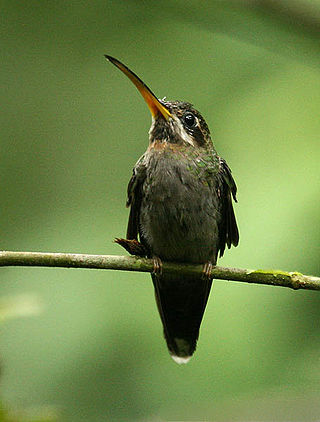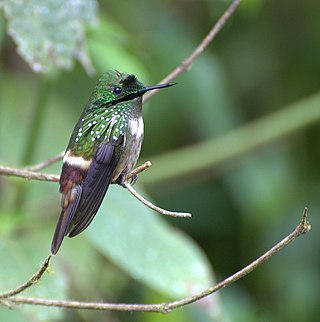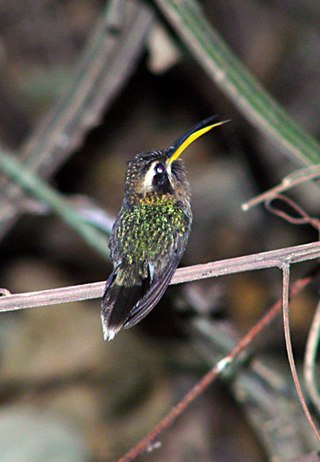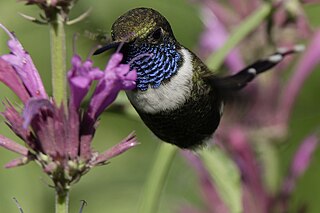
The white-whiskered hermit is a species of hummingbird in the family Trochilidae. It is found in Colombia and Ecuador.

The band-tailed barbthroat is a medium-sized hummingbird that is found from southeastern Guatemala and Belize to western Ecuador and western Venezuela.

The bronzy hermit is a species of hummingbird in the family Trochilidae. It is found in Colombia, Costa Rica, Ecuador, Honduras, Nicaragua, and Panama.

The broad-tipped hermit is a species of hummingbird in the family Trochilidae. It is endemic to Brazil.

The tawny-bellied hermit is a species of hummingbird in the family Trochilidae. It is found in Colombia, Ecuador, and Peru.

The hook-billed hermit is a threatened species of hummingbird in the family Trochilidae. It is endemic to a small area of Brazil.

The velvet-browed brilliant is a species of hummingbird in the "brilliants", tribe Heliantheini in subfamily Lesbiinae. It is found in Brazil, Guyana, Suriname, and Venezuela.

The festive coquette is a species of hummingbird in the "coquettes", tribe Lesbiini of subfamily Lesbiinae. It is endemic to Brazil.

The black-throated hermit is a species of hummingbird in the family Trochilidae. It is found in Colombia, Ecuador, and Peru.

The straight-billed hermit is a species of bird in the family Trochilidae, the hummingbirds. It is found in Brazil, Colombia, Ecuador, French Guiana, Guyana, Peru, Suriname, and Venezuela.

The scale-throated hermit is a species in the hummingbird family Trochilidae. It is found in Argentina, Brazil, and Paraguay.

The grey-chinned hermit is a species of hummingbird in the family Trochilidae. It is found in Brazil, Colombia, Ecuador, Peru, and Venezuela.

The minute hermit is a tiny species of hummingbird in the family Trochilidae. It is endemic to Brazil.

Koepcke's hermit is a species of hummingbird in the family Trochilidae. It is endemic to Peru.

The great-billed hermit is a species of hummingbird in the family Trochilidae. It is found in Bolivia, Brazil, Colombia, Ecuador, French Guiana, Peru, Suriname, and Venezuela.

The needle-billed hermit is a species of hummingbird in the family Trochilidae. It is found in Bolivia, Brazil, and Peru.

The reddish hermit is a species of bird in the family Trochilidae, the hummingbirds. It is found in Bolivia, Brazil, Colombia, Ecuador, Peru, Venezuela, and the Guianas.

The sparkling-tailed woodstar, also known as the sparkling-tailed hummingbird, is a species of hummingbird in tribe Mellisugini of subfamily Trochilinae, the "bee hummingbirds". It is the only species placed in the genus Tilmatura. It is found in El Salvador, Guatemala, Honduras, Mexico, and Nicaragua.

The planalto hermit is a species of bird in the family Trochilidae, the hummingbirds. It is found in Argentina, Bolivia, Brazil, Paraguay, and Peru.

The Talamanca hummingbird or admirable hummingbird is a species of hummingbird in the "mountain gems", tribe Lampornithini in subfamily Trochilinae. It is found in Costa Rica and Panama.
























